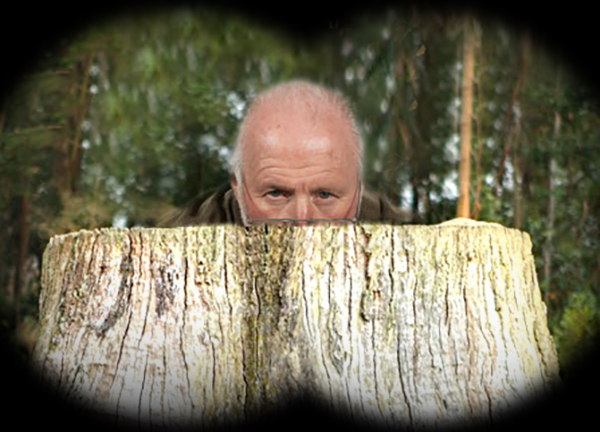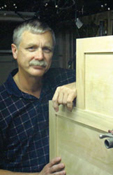
One of the reasons my wife and I bought our current home is the two-acre margin of woods that surrounds our lawn. We were taken by the natural setting those woods provided for our home. I also liked the idea of owning a supply of hardwood I could access whenever I wanted.
The first tree I harvested from the woods—a black cherry– is now a ¾-sized Queen Anne highboy which stands in our bedroom. In one of the highboy’s drawers, we have a photo of our now-25-year-old daughter sitting at age 2 on one of the logs sawn up later to make lumber for that highboy.
My dad, who was then in his early fifties, had some experience cutting timber. As a home builder, he’d taken down trees on some of the lots on which he’d built. Plus, in the late 1940s, after graduating from high school, he’d worked for the Forest Service in the Pacific Northwest. Although I had never taken down any trees of noteworthy size, I had acquired some experience with a chainsaw, preparing firewood for the stove with which I heated my shop.
We were, I believed, reasonably accomplished woodsmen.
One warm spring morning, my dad and I carted our gear—chainsaw, gas, oil, axes, rope, safety glasses and ear muffs—into the woods to take down the cherry.
The tree had a diameter at breast height of about 24 inches, and the bottom 12 or 14 feet were straight and free of limbs: a perfect sawlog. Unfortunately, the cherry stood on a hillside surrounded by other trees and it had one enormous limb jutting out about 45 degrees from the face of the gentle slope above which the tree stood.
When I looked at the enormous limb, I saw more usable cherry. What I didn’t see was the seductive pull of gravity.
Before we started up the chainsaw, we surveyed the area to determine the best direction in which to down the tree. We drank coffee, chopped away small trees and limbs that might interfere with the cherry’s descent, and argued quietly about the best placement for the notch. We knew we wanted the tree to fall downhill—it was already leaning slightly in that direction—but it couldn’t fall straight downhill because that would entangle the cherry in a maple immediately below it, so we had to cut the notch so that the cherry fell either slightly left or right of straight downhill.
When we had cleaned a felling zone, we fired up the chainsaw and cut a generous notch angled just a bit to one side of straight downhill, a notch we hoped would drop the tree in the area we had just cleared.
 My dad then started the back cut a bit above the notch on the side of the tree opposite the notch.
My dad then started the back cut a bit above the notch on the side of the tree opposite the notch.
We thought our plan was a good one. The hinge he would leave when he’d finished the back cut would be perpendicular to the tree’s intended line of fall, guiding the tree into our felling zone.
At first things went according to plan. When the tree began to creak, my dad pulled out the saw, shut it off, and the two of us retreated to a safe distance and waited.
And waited.
After maybe five minutes, my dad fired up the chainsaw a second time and cautiously approach the tree which—as far as I could tell– had not yet moved so much as a millimeter in its direction of fall. He worked the bar of the saw into the cut and removed another ½” of wood, then clicked off the saw and retreated again.
Nothing. A slight breeze rustled the leaves above us. Birds called to one another in the silence left behind after the chainsaw’s rattling growl.
We looked at one another. “Maybe if I got a rope up there,” I said pointing to the limbs of the cherry, “I could go downhill and pull enough to get it started.”
We thought about that and waited, hoping the tree would break free.
“I’ll try the chainsaw again,” my dad suggested. He started the saw, moved closer to the tree butt, nudged his saw into the cut, and nibbled away at the back side of the hinge.
Suddenly, the tree snapped and cracked and began to lean in the proper direction, guided by the notch and the hinge. But then gravity grabbed the heavy jutting limb and twisted the tree, altering the direction of fall so that the tree was perfectly aligned in the one direction in which we absolutely did not want it to fall.
It leaned, leaned, leaned and then—about 45 degrees from the vertical—it came to rest, its branches entangled with the branches of the maple standing directly downhill.
We approached the stump. The hinge we’d left to guide the fall was still intact but twisted now, and the tree—which had looked almost slight when it was standing straight up and down now appeared to weigh about as much as—say—the planet Jupiter.
Here’s what we did in the next two hours:
1. I tied a rock to the end of my rope and threw the rock up into the cherry’s branches where that end of the rope snagged. Then we went downhill and tugged on the other end of the rope. Nothing.
2. We climbed up into the partially fallen tree, bouncing up and down on the trunk. Nothing.
3. I shook my fist at the tree.
4. We nibbled away at the hinge with the chainsaw, and the butt did eventually break free, but even then the tree didn’t fall. It’s branches remained hung up on the branches of the maple.
Then we walked to the house and had lunch, which turned out to be the most productive thing we’d tried because when we returned to the woods, the cherry had freed itself from the nearby maple and had settled to the ground.
Or more accurately, gravity had freed it. Gravity, it seems, is a much more powerful force than a chainsaw, a rope (with rock), an angry fist, or a pair of inexperienced woodsmen with good intentions and little real experience.
-Kerry Pierce





